
What is a Fix and Flip?
A fix and flip (also known as house flipping) is a type of real estate investment in which an investor buys a house, renovates/ repairs it, and then sells it at a profit months later. Fix and Flips can be very profitable if done correctly. Making bad decisions, however, during the course of a fix and flip can lead to very costly mistakes. In an effort to ensure that your fix and flips don’t flop, we’ve put together this blog. Every week, on Flip Tip Tuesday, we will add another installment to help you make sure your investments stay flippin’ fantastic!

#1: Location is key.
You’ve heard it said before. Real Estate is all about location, location, location. It pays to do your due diligence before jumping into an investment property. For an investment to work, it has to be located in a desirable neighborhood where people want to live, and it has to be profitable for you. In order to insure this, it is very helpful to do a location market analysis.
The first step is to make sure your location is in a good investment area. Factors to consider include the following. The local area job market and median salary trends of your investment location will determine if people can afford to buy your investment. It may also be helpful to consider if this is an up and coming area, and whether the population is increasing or decreasing. This will definitely impact your ability to sell your investment property for a good profit.
The next thing to consider is if your investment property is in a desirable neighborhood. There are many factors that go into this: school district, access to highways and public transportation, accessibility to shopping and restaurants, scenic views, local attractions, safety and crime rates, property tax rates, etc…
There are many resources you can use to find out this information. The best place to start is your local realtor. Realtors are a great source of information for market trends and location information. But don’t let your research end there. There are a plethora of websites that can aid in your research. Among them are Chambers of Commerce, your local realtor associations, market reports on Trulia and Zillow, and many more. Also, don’t be afraid to talk to other investors and residents in the area. Often times they can add valuable insight into location trends.
Once you’ve found your ideal investment property location, you are well on your way to making a profitable fix and flip investment. Tune in next week for our discussion on Timing… Until then, Happy Flipping!
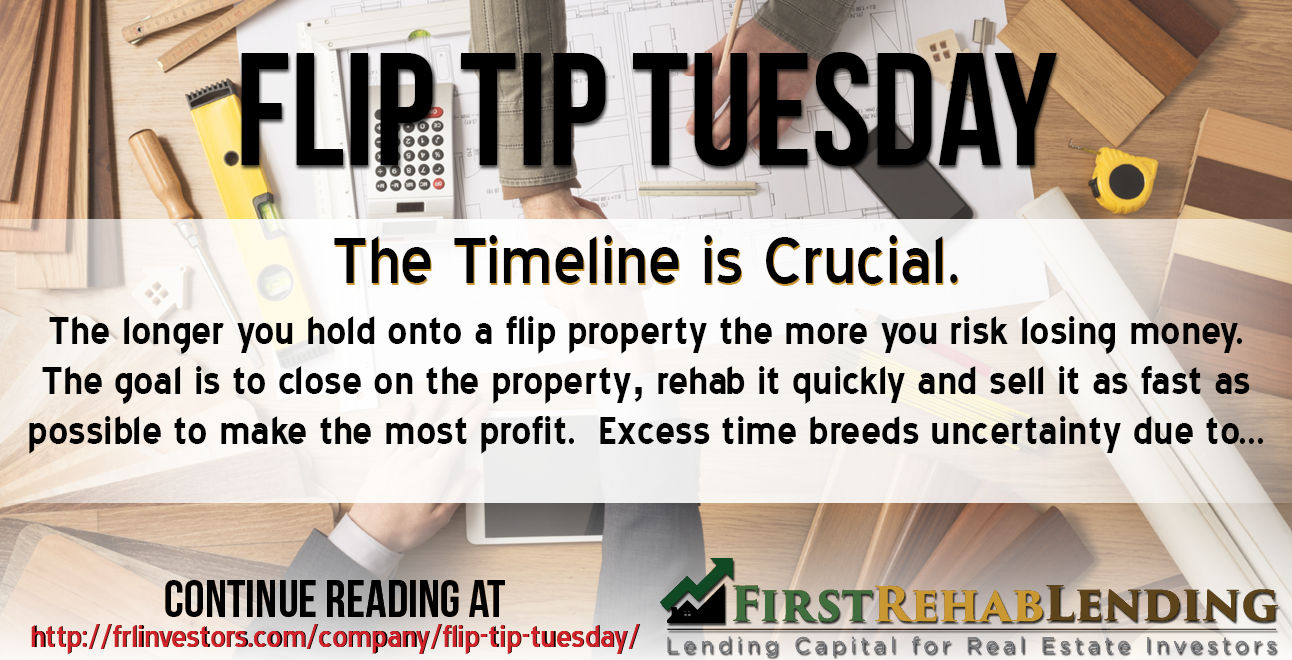
#2: The Timeline is Crucial
The longer you hold onto a flip property the more you risk losing money. The goal is to close on the property, rehab it quickly and sell it as fast as possible to make the most profit. Excess time breeds uncertainty due to uncontrollable circumstances. Any number of things can happen. The market can take a turn for the worse. You can experience problems during your renovation. You could experience delays because of weather. And all the while interest keeps accruing on any financing you may have.
In order to execute your fix and flip as quickly as possible you must be prepared and organized. You should have all of your service professionals in order before you start: your financing, your contractor(s), the realtor who will sell your finished project. These are the people who could make or break your deal. Be sure to check their references, get competing bids, and familiarize yourself with their style of conducting business.
You should also make sure you are familiar with the municipality’s procedures, rules and regulations regarding renovations so you are not blindsided by difficulties obtaining permits or actually performing the work.
Remember to factor in the time it will take to have the house on the market before it sells. Your realtor is your best source of knowledge on this topic. The realtor can tell you the average days on market for your location and help you price the property right so it sells as quickly as possible.
The more research you do before you purchase the property, the less time you will waste during the process, and the more money you can put in your pocket at the end. In the coming flip tip Tuesdays we will go into more details on many of the items that we’ve mentioned above so stay tuned. Until then, please contact us if you have any questions. Happy Flipping!

#3: Know Your Numbers
The whole reason for fixing and flipping is obviously to turn a profit. House flipping experts agree that in order to have a successful flip you must see profit margins ideally between 20-30%. In order to do so, it’s important to know your numbers from the very beginning to make sure that your investment will be worth it in the end.
The most important number to know is the After Repaired Value (ARV). That is the value of your investment property after all repairs have been made. This value will determine the final sales price of your investment property. Your best source of information for this is a knowledgeable area realtor. A capable realtor can run a Comparative Market Analysis (CMA) of the similar houses in the area to determine how much your rehabilitated investment property would be worth. This is very important information.
Once you know the ARV you can subtract all the costs of buying and rehabilitating to calculate whether your flip house will turn the profit you need to make it successful.
It is important to know and not underestimate all the costs involved. Below is a list of costs that could be associated with your flip project:
- Acquisition costs (purchase price, inspections, closing costs, recording fees)
- Carrying costs (Insurance, taxes, maintenance, utilities, etc. …)
- Loan costs (appraisal fee, processing fees, interest, points on your loan, etc. …)
- Rehabilitation costs (costs of doing any repairs and renovations)
- Selling costs (real estate commissions, recording fees, closing fees, etc. …)
Of all of these costs, the most difficult to pin down are the rehabilitation costs. It’s imperative to get competing bids from trustworthy contractors for the work you need done before you actually buy the flip house. This will ensure that you are getting the best price and best professional advice. And even then, your cost estimates may be too low. The reason for this is that once you start repairing/ renovating a house you often find repairs or problems you weren’t counting on. This can happen to even the best and most experienced contractors. Even they can’t see through walls.
Another variable to consider is that it may take longer to sell the property than you were anticipating, thereby increasing your carrying costs. Because of these contingencies, it is smart to add a miscellaneous costs line item of 15-20% of your rehab and carrying costs to your calculations so you are not cut short on your budget.
All of these costs together subtracted from your After Repaired Value (ARV) represent your gross profit. If it’s between 20-30% of the ARV, you most likely have a successful flip.
Once you know your numbers and have your budget established, respect the budget. If the numbers don’t make sense on paper, they certainly will not make sense in real life. It’s always much better to skip a flip project than to sustain a loss. Remember to tune in every Tuesday to get helpful tips on your flips! Until then, Happy Flipping!

#4: Know Your Buyers
In order to have a successful flip, it is important to know the type of buyer who will buy your refurbished property. You should rehab the house with that buyer in mind. It doesn’t matter what appeals to you.
The location will determine the type of buyer you will attract. What kind of neighborhood is the house located in? Is it a neighborhood with many young families or an older community with many retirees? What is the median income of the area? Is there a special interest that draws people to that neighborhood?
If your flip house is in a neighborhood with a great school district, for example, your target buyer is most likely a younger family. For young families, an open floor plan may be more desirable. Plan your layout to make the family area open and inviting, but also provide enclosed spaces to give the parents the privacy they need. Make sure there are enough bathrooms throughout the home. In young family homes, the parents are compromising on the size of the master bedroom in favor of the kids’ rooms. An extra selling point could be adding a playroom/study area that would give the parents that extra space to grow with their children.
If you’re looking in a neighborhood that draws in mostly retirement-aged buyers, look for a rehab home with one level or a ranch style. These buyers are looking for a home that will work for them as they get older with a layout designed for universal accessibility. This might be their last home purchase so you want to consider adding in features that will make life easier: slip resistant surfaces, twist-free faucets and maintenance-free outdoor space.
Once again, your realtor is a great source of information on the neighborhood and the types of people who are attracted to it. Beyond that, look in local publications to get a feel for the type of community it is. Drive around and see for yourself. Who lives there? What types of stores and restaurants are there?
Just a little research will help you understand your potential buyers and what types of features might be important them. Designing your rehab with these features in mind will be the difference between a quick and easy sale and a house that stays on the market for months without any offers. It pays to do your homework!

#5: Find Knowledgeable, Local Real Estate Agents
It is nearly impossible and definitely impractical to flip a home on your own. There is too much involved in the process for any one person to be an expert on all aspects of flipping. Flippers work against the clock, having to locate the right property, then renovate it on budget, and finally turn it around and sell it before the financing costs eat up their profits. It’s important to build a strong team of professionals to help you on your projects and to ensure you complete them in a timely manner with the maximum profit in each flip.
The first set of specialists you need on your team is a few great real estate agents who are experts in the markets you are working in. Good realtors are knowledgeable about house values in their market, market conditions and trends, market demographics and which features make a house sell more quickly in their market. Building relationships with real estate agents can also get you property listings before they hit the market, giving you the advantage to bid and close on a property first. They also have the experience and skill set needed to make sure your flip is priced to sell when you’re ready to put it back on the market so that it moves quickly.
Real Estate Agents can also be useful for finding “off market” short sales, estate sales and wholesales. If you find a real estate agent with a direct link to the asset managers from a bank, you will be in a great position to know ahead of anyone else when deals become available.
When searching for a real estate agent there are a few things to look for. An ideal real estate agent has years of experience and knowledge in the area in which you are investing and can assist in your negotiations. A great place to find an agent that will understand what you’re looking for is at your local Real Estate Investment Association (REIA). Be sure to interview and research your agent. You should be readily able to find your agent online, and with little effort, be able to see how active they are in the market place and whether they have good reviews from other investors. Ask for references and a detailed description of how they can help you achieve your goals.
When working with an agent, it is a good idea to inform him/ her about your business model and where you are looking to invest. Create a relationship where the agent can make money by selling the property to you as well as selling the property for you when the renovations are complete, and you will have a loyal agent who is actually part of your team.
Having a solid team of realtors on your side can make or break your flips. With some research and perhaps a little trial and error, you should be able to build a cohesive team of realtors to help you ensure that your investments stay profitable and on target.
Be sure to tune in next week to read about what other specialist can help you lock in your profit!
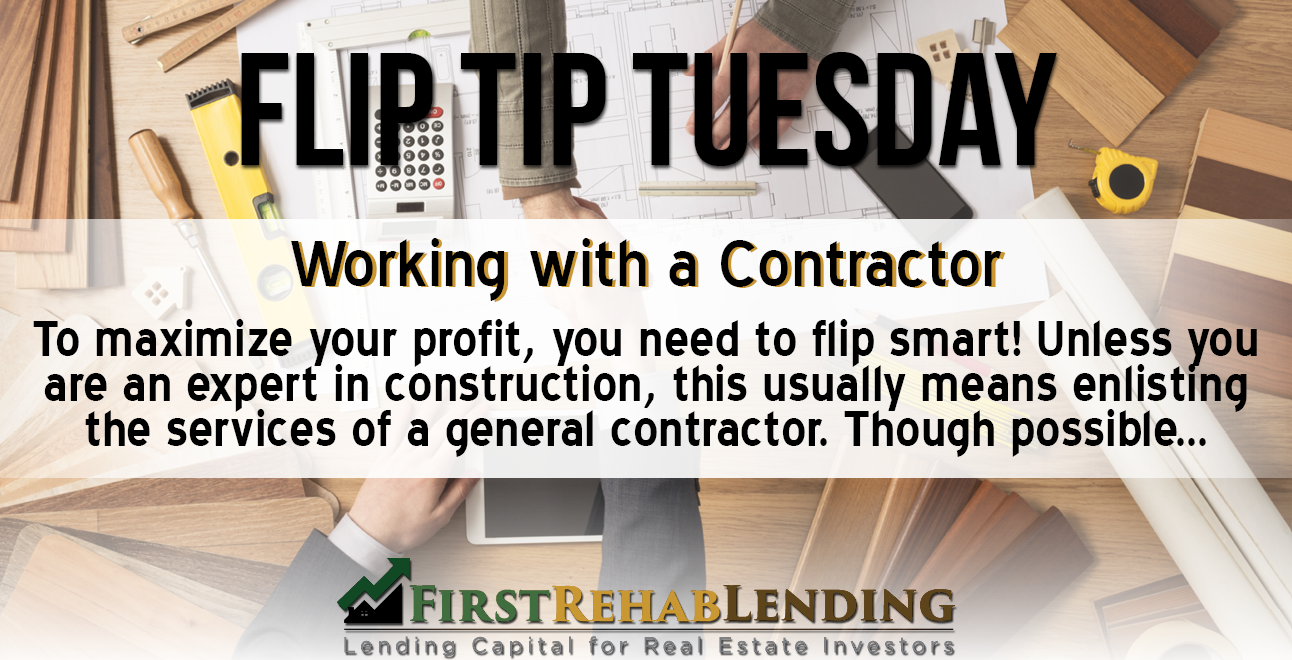
#6: Working with a Contractor
To maximize your profit, you need to flip smart! Unless you are an expert in construction, this usually means enlisting the services of a general contractor. Though possible to complete a flip without a contractor on your team, you may waste time and money rehabbing a home without using their expertise.
If you’re new to the flipping industry buying a rehab home that just needs a little cosmetic work may seem very do-able. Often times, however, the best deals are the ones that require the most construction work. Additionally, there are many factors to consider that may not be so obvious to someone who is not well versed in construction. For example, the age of the home can affect the electrical and plumbing systems, and renovations to the kitchen and bathrooms. For most house flips, the time you’ll spend doing things that otherwise could be done by a professional may cost you more money.
Contractors can be helpful throughout your flipping process. Before you even buy your flip house, you can use their advice on how much you will spend repairing and updating the house so you can determine if there is enough room to turn a respectable profit. After you’ve purchased the property and start the renovations, a general contractor will run the entire project to make sure it is flipped in a prompt manner. They manage everything that goes on with your rehab, including hiring subcontractors to get the job done. Managing all this can be a real headache if you don’t have a building background.
So how do you find a general contractor who can work within your budget and who has a good track record? A good starting point is to get referrals from people you trust. You should definitely get at least 3 competing bids from different contractors to ensure that you are receiving fair pricing and accurate advice. Each of these contractors should also provide their own references that you can call. Be sure to check that they have the proper licensing and insurance, including workers’ compensation. Ask lots of questions during the interview process to make sure you and the contractor are on the same page about the renovations and the budget.
Once you have chosen a contractor, the best way to make sure everything runs smoothly with the renovation of your investment property is to have a detailed contract with your contractor that is agreed upon and signed before the work starts. The scope of work for your rehab needs to be written out precisely, including any permits and inspections required to certify the work and to obtain a Certificate of Occupancy, if necessary. The contract should detail the materials and fixtures including all grades and model numbers, the exact paint colors and finishes, and whether you will buy the materials and deliver them to the job or your contractor will. It should also spell out the start date, how many days per week they will be working, and a projected end date. You should understand that sometimes unforeseen circumstances (such as problems that were unseen originally because they were hidden behind closed walls) are possible requiring a change in price and timeline to the contract. The terms for requesting and approving a change order should be spelled out clearly in your contract to avoid future disagreements with your contractor. The contract should list any other subcontractors that will be on the job along with their scope of work and their licensing and insurance as well. It should also list who will be responsible for rubbish removal. Finally, the contract should clearly state the price and the terms of payment. The more detailed the contract, the smoother your flip project will flow.
Though you may go through a few contractors before you find the ones you like to work with, it’s worth the research and the due diligence to do so. Having a good contractor on your house flipping team will help you to save time and flip within your budget. Leveraging their knowledge and building a solid relationship are some of the biggest keys to success when flipping houses.

#7: Hire a Real Estate Attorney
One of the most important professionals you should have on your team is a Real Estate Attorney. A lot of flippers try to cut costs by seeking legal advice online for a discounted rate. However, as is usually the case, you get what you pay for. Flipping houses is a tricky business and can get legally complicated quickly.
For first time flippers, attorneys can be helpful in establishing your business venture as a corporation or LLC. You will need to do this if you intend to use outside financing. For a corporation, you will have articles of incorporation and by-laws and for an LLC, there will be articles of organization and an operating agreement. An attorney can help you decide which of these options is best for your case. These entity documents should definitely be prepared by an attorney to avoid delays or issues at closing that can arise from improper formation or documents.
It is impossible for a flipper to keep up with all the laws and regulations in each state for real estate investing. The best course of action is to hire a professional who does so for a living. Real estate transactions require many crucial documents such as the deed, mortgage loan documents, bills of sale, survey, title and insurance policy. They should all be reviewed for any legal irregularities by your real estate lawyer.
One of the most important documents is the purchase and sales contract since this is essentially what will define your agreement with the seller to buy their property. This contract usually favors the seller, and buyers don’t always know what should and should not be included. For example, with time being of the essence, the short inspection period allowed by contract can slip by without the buyer having an opportunity to do a proper inspection. An attorney will be able to negotiate an extension with the seller’s attorney. This little bit of extra time can give you the opportunity to make certain that your investment is a good one. Even if you find latent faults that were not readily visible during your first property tour, with the proper inspection you could give you the opportunity to negotiate the price of the sale down, through your attorney of course.
Investors don’t always know what the process will look like as they go through the loan application stage and when they get to closing. Having a good attorney on your side ensures that someone who represents your interests is making sure the process is going the way it should.
On the day of closing, it is important to bring with you anything that the lender, Title Company, or any other interested party requires such as proper identification, the proper certified checks for down payment and closing costs, a voided check to set up mortgage payments, etc… Your attorney will give you an exact list of everything you need. At the closing, he/she will review all the closing documents for propriety, and can offer experienced advice on this overall process.
Although the expense may seem high initially, a good real estate attorney can save you from an investment disaster. If you skimp on legal services, you could pay for it in the long run and may even lose the deal if things don’t work out. Having legal representation will diminish your risks of falling into legal snags and increase the profitability of your rehab in the long run.

#8: Having a CPA on your team
An accountant is an important member of your team who can play a large role in your ability to find and leverage as many tax benefits as possible. It is important to find a Certified Public Accountant (CPA) who is familiar with tax laws for house flipping and real estate investing. He /she will offer advice regarding the minimization of your tax liability by taking advantage of all possible tax deductions.
An accountant will advise you of the tax advantages and requirements of different business structures, such as, sole proprietorships, limited partnerships, limited liability companies and corporations. He/she will also assist you in keeping your flips organized by tracking your business expenses and preparing tax statements throughout the entire flipping process. When the time comes to sell the property, you will have all the necessary tax requirements in order, which avoids any unseen decreases in final profits.
Having a good accountant will also help prevent issues with the most unintended members of the flipping team, the Internal Revenue Service (IRS) and state tax authorities. Both will certainly look into your property flipping transactions. Continual house flipping can lead the IRS and state tax authorities to think you are running house flipping as a business, which causes an increase in taxes and leads to a self-employment tax. Having an accountant on your team ensures that everything is being done correctly under tax law and can save on penalties and fees in the long run.
Another important tax consideration is how long you hold a property. Flipping transactions are taxed differently depending on the length of ownership. If you keep the property for more than a year, federal law rewards you by classifying any profit from the sale as a “long-term capital gain”. That means the tax rate on your profit is much lower, maxing out at around 20 percent for investors even in the highest-income tax bracket. But if you flip in less than a year, tax rates can be substantially higher. Money you make by buying and then selling that same property in less than a year is considered a “short-term capital gain” and is taxed as ordinary income-tax rates. Each state tax authority has its own regulations regarding the length of the ownership of the property. A good CPA will help you navigate all of this so you don’t take a large hit to your profits.
So, while a CPA may, at first glance, seem like just another added and unnecessary expense to your flipping business, your accountant is actually the protector of your money. It makes sense to do your research to find an experienced CPA to help keep your flips in profit territory. Until next week, Happy Flipping!

#9: Working with a Hard Money Lender
As a real estate investor, you know the importance of doing your due diligence before picking your next real estate investment. You are aware that you need a solid team by your side: realtors to help choose the perfect property, contractors you trust to rehabilitate the property, a real estate attorney and other experts to maximize your chances of a successful flip. These skills are of little benefit if you cannot secure financing at the right time. Having a relationship with a reputable hard money lender is essential to your investing success.
A hard money loan is a type of short term asset-based commercial loan offered usually by private money lenders. A hard money loan differs from a traditional residential mortgage in that it is not regulated by Dodd Frank, the Truth in Lending Act, and other Federal laws that put very high regulatory demands on banks issuing residential mortgages. Typically, the primary basis for extending the credit is the value of the collateral property. The lender will usually lend between 65-75% of the value of the property. Because these loans present a higher risk-level for the lender than a traditional mortgage, interest rates tend to be higher. However, these loans offer higher flexibility, less documentation and quicker approvals and funding than traditional mortgages.
Using a hard money lender can help you get into your project quickly without putting a huge financial strain on your wallet upfront. In the fix and flip industry, timing is everything! Having a quick turnaround time for funds availability on a project is a must. Working with a good hard money lender gives you access to quick funding, which will give you the leverage you need to negotiate effectively with the seller. The reality of having readily available funds is a large incentive for sellers to accept your offer quickly.
Working with a good hard money lender makes getting a loan for your investment property convenient. Applying for a traditional mortgage is time consuming. It can take months to close on a loan, which puts investors at risk of losing out on an investment property. With a hard money loan, it’s possible to get funding in a matter of weeks. Hard money loans are a good fit for investors who need to get funding for an investment property quickly, without any restrictions you would have with bank financing.
There are two other important benefits to using hard money: leveraged returns and the ability to grow and execute more deals simultaneously with a fixed amount of capital. Using hard money in your business model can help you grow your business and diversify your risk across multiple projects.
Like selecting any other team member, you need to do your due diligence when choosing a private lender. Look for lenders that focus on and have experience in fix and flip loans. When evaluating hard money lenders, pay close attention to the fees, interest rates and loan terms. If you end up paying too much for a hard money loan or don’t pay within the loan period, this can negatively influence the profitability of your investment property.
In short, using the right hard money lender for your flipping venture can be a huge benefit, increase your profit margins, help you grow your business, and allow you to diversify your investments. For more information on hard money loans visit www.frlinvestors.com.

#10: Value of Networking
Networking is one of the keys to success in any industry, most especially in the flipping industry. Your network ultimately leads to your net worth.
Whether you are new to flipping or are a seasoned investor, professional networking should be a fundamental component of your business plan. The risks are simply too high and the margins too narrow to flip on your own without a reliable team. It’s essential to have people looking out for your flipping opportunities and professionals who are ready to start your project as soon as possible so you don’t lose out on a deal. As with other industries, the more people you interact with, the more likely you are to meet the key players who can positively impact your business, and the more business you stand to gain.
But where do you begin? Connecting with your current contacts and telling them what your goals are for your flipping business is a good start. Ask them if they know anyone they trust in the fields of real estate, construction, accounting, real estate law, etc… Even if these people cannot help you they can always lead to others who can.
Attending Real Estate Conferences or Seminars is a great way to meet experienced professionals in the market as well. Contractors, investors, lenders and real estate agents attend these events to share knowledge, learn trends, and do networking of their own. Many networking events are not only centered on interactions with other investors, but also feature expert guest speakers on topics of interest to the group.
Look for Meet Up groups in your area that are real estate focused. Join the local Real Estate Investment Association (REIA) or real estate investment club. Surrounding yourself with the top people within the real estate investing world will allow you to increase your knowledge and build a network of helpful professionals. In real estate investing, the players are always either buying or selling something. The more exposure you have to these people, the greater success you will have in the industry. You will be exposed to many tips and new ideas. You will get access to more deals by engaging in and building better relationships with others in the industry. You may even find the people who will help you find and close your own deals. The more success you have, the more opportunities will turn up. That’s just how it works.
In today’s digital world social media networking is also a great way to grow your business. By connecting and staying in touch with professionals in your area and joining local online real estate investment groups online, you will be exposed to local professionals in your target market. Don’t forget to use and follow specific hashtags in a specific geolocation to see and interact with the players involved in the flipping industry in your area. Some sample hashtags to start with are #realestateinvestorsny (insert your appropriate location) #propertyflippingny #investmentpropertiesny, etc… Get creative, you never know who you will meet or what opportunities you will find.
However you choose to do it, get out there and start networking. Whether it is a contractor, lender, agent, or lawyer, you will need a team of reliable and effective service providers at every stage of your real estate investing journey to ensure your success. The more people you meet and interact with, the more likely you are to find the best professional, mentors and colleagues out there. In the wise words of Reid Hoffman (co-founder of Linked In), “No matter how brilliant your mind or strategy, if you’re playing a solo game, you’ll always lose out to a team.”

#11: Finding Undervalued Property
The best investors don’t look for the perfect locations, amenities, and overall quality of a home, they look for the perfect opportunities such as undervalued properties. Undervalued properties do not exist around every corner but finding one can lead to a very profitable flip.
In order to know whether a property is undervalued, you must know the market you’re looking into. What are the historical selling prices over time? What are the current listing prices of the properties for sale in the area? How are prices trending? What types of houses are selling the fastest? Having the answers to these question can give you great insight into whether a property is undervalued.
But how do you find one? Your network, as usual, is a great place to begin. They operate in your marketplace and have their finger on the pulse of the existing opportunities.
You might also consider buying a bank foreclosed property. These properties can be some of the best deals you’ll find on the market. Banks typically don’t want to hold onto properties they have foreclosed upon because it costs them money to keep them maintained and to sell them at market value. The foreclosure process can take years, during which a house can fall into disrepair. For these reasons, banks tend to offer huge discounts on bank-owned property just to recuperate the money that was owed to them and cut their losses. Real Estate agents, banking professionals, and public records searches are a few ways to find out about bank foreclosed properties.
Attending auctions is also a great way to find undervalued houses. There are two main types of auctions, foreclosure auctions and tax lien auctions. Both options usually start the bidding at the price of the debt or below. Unfortunately, the bidders do not always have the opportunity to inspect the properties before they submit a bid, but even so, the auction prices start so low that looking at the house may not be necessary. Once again, it’s important to know your market so you can run accurate numbers eve for a worst case scenario before bidding on a property.
Finding a very motivated seller is another way to purchase an undervalued property. It’s not always the highest offer for a property that gets accepted but simply the first. A seller who needs to relocate quickly may accept a cheaper price guaranteed in the moment over the chance of a better price tomorrow. You can obtain good leads on motivated sellers by working with real estate agents who know their markets well.
On the flip side, another way to find great deals is to look for properties that have been on the market for a long time. Those owners are often far more willing to sell for a discount because they are tired of holding on to that property. Often times, the owner has been making two mortgage payments and will entertain almost any offer. Again, your real estate agents can be of help finding these types of sellers as well.
Regardless of how you find it, it’s important to understand that finding the “perfect” property to flip is all a numbers game. A property that seems undervalued at first, may actually have underlying problems that are costly to repair. So it’s important to do your homework, run your numbers and consult your experts.
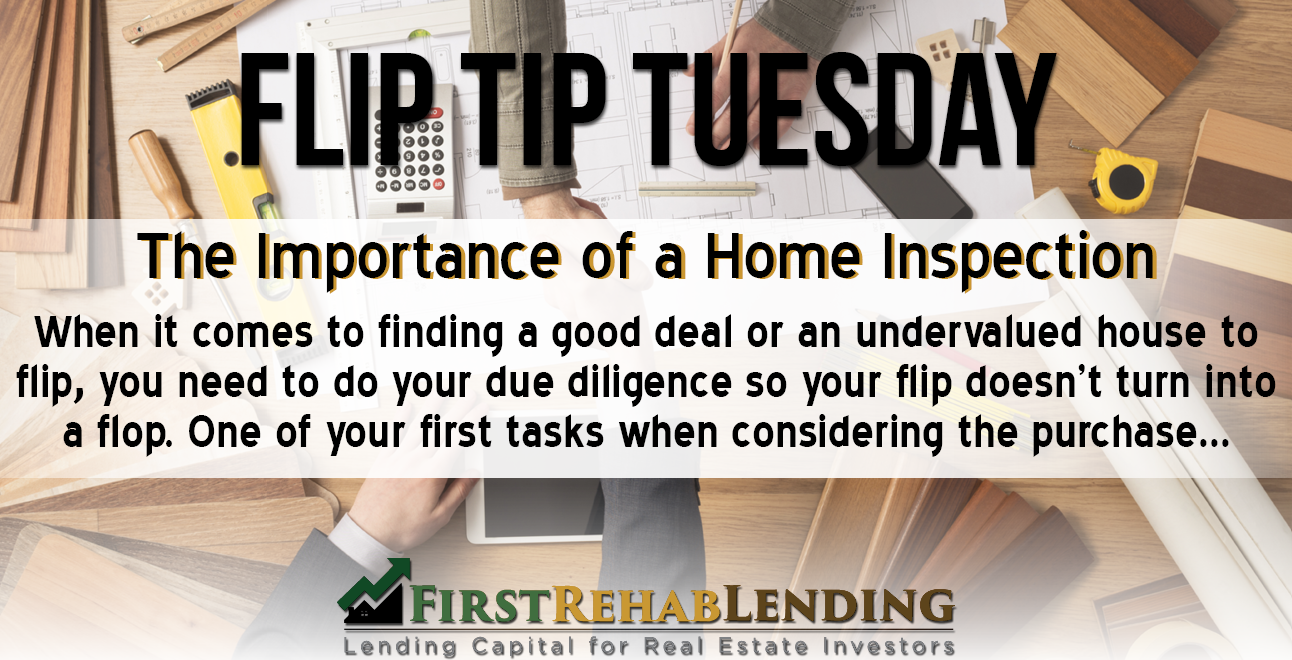
#12: The Importance of a Home Inspection
When it comes to finding a good deal or an undervalued house to flip, you need to do your due diligence so your flip doesn’t turn into a flop. One of your first tasks when considering the purchase of a house is to hire a qualified, licensed home inspector. This will reveal to you how flip-able and profitable the house will be in the end.
It’s hard to know what a property’s true condition is just by walking through it for a few brief moments. Most investors will want an inspection contingency in the contract of sale that allows you to hire an inspector to do an in-depth analysis of the condition of the house to uncover any hidden problems before purchasing the property.
You will want to be sure you’re not buying something more damaged than your budget can handle. Hiring a qualified licensed home inspector can tell you a lot about the property in question. This includes the things you probably wouldn’t notice yourself unless you’re a general contractor, such as the condition of the foundation, the wiring, plumbing, roof, and more. As an added bonus, by going with an inspector to view the house, and asking questions, you can also learn what major red flags to generally look for in buying an investment property.
After the inspection is completed, you will receive an inspection report. Keep in mind that it is a home inspector’s job is to find problems. Don’t be scared when they hand you a whole list of them. After all, you are expecting to remodel this house. The list is there to help you determine if the repairs needed are worth your time and money, and if you can still turn a profit on the sale after all is said and done. You may not want to fix every single thing in the inspection report, but the inspector will usually let you know what needs attention in order to make a profit. The list of problems can also be instrumental in negotiating down the purchase price of the property.
But how do you find a qualified home inspector? Your first place to turn should be your trusted realtor. They deal with home inspectors at almost every transaction and usually know some reputable ones. You can also ask your network which home inspectors they work with and trust. The certifications and licenses required for a home inspector vary from state to state. Be sure to verify that your home inspector meets all the state requirements. It’s also a good idea to ask if they are a member of any professional home inspection associations. The American Society of Home Inspectors (ASHI), for example, is a great professional organization. They require strict testing and a minimum of 250 home inspections completed before the inspector can qualify for membership. Ask for experience and references, as well, to be sure you are working with a capable professional. Also ask for a list of points to be inspected so that you are certain that all your points of concern will be addressed.
Once you have your home inspection done, you are ready to run the numbers to ensure that your purchase is worthwhile. No matter what the condition of the house you want to flip, the home inspection can make the difference between getting a good buy and sustaining huge losses from unforeseen circumstances during the process of flipping the home.

#13: Improvements that Will Raise the Value of Your Investment Property
When flipping a house, it’s important to remember that the entire reason for making improvements is to get the highest selling price possible when you sell your investment. The improvements/repairs should be made to satisfy the tastes and desires of your potential buyers, not necessarily your own.
There are basic improvements that can give your rehab great curb appeal, and structural improvements that can turn your fixer upper into your buyer’s dream home, but they often vary by location. Speaking to a local realtor in your target market, about what features are most desirable and appropriate, can save you money by preventing well-intended but unnecessary upgrades. With that in mind, below are some common renovation areas that typically work to secure higher home prices in just about all areas.
Landscaping, which is often an after-thought to a house flipper, is one of the top investments that brings a significant difference in the selling price of a house. Tangled trees and unkempt bushes can obscure views, darken interiors, promote mold, and block a good look at the house. Landscaping is also the first thing a buyer sees as they drive up to the house, so it is truly instrumental in making the buyer’s first impression of the property. So at a minimum, you should make sure the landscaping is neat and clean.
The layout of your investment property is also an adjustable feature that can be renovated to maximize value. In many markets that consist of young couples and families, today’s buyers are looking for an open floor plan. Bigger isn’t always better, but strategically increasing the amount of living space will boost home value. To achieve this, knock out a non-structural wall, remove the walls from the dining area or even remove the kitchen island. Anything that opens the space and creates a sense of flow in the house is generating a response from buyers.
Bathrooms and the kitchen are great rooms to renovate because they tend to be the most important rooms to buyers, and are therefore a sure bet for adding value. You can make small inexpensive improvements that make a huge difference in the bathroom. These include replacing the mirror, cleaning the grout, removing rust stains, applying fresh caulk, updating doorknobs and cabinet pulls, replacing faucets, and installing a low-flush toilet. Even buying a new toilet seat can make a difference. For kitchen renovations, it’s not always necessary to rip it down to the studs. A smaller investment can have serious impact. For as little as $5,000, you may be able to add a new suite of appliances, as well as a new countertop and flooring, resulting in a fresh, coordinated look.
Don’t overlook the materials you’re standing on. Real Estate professionals usually recommend spending some money on floors. Older homes may have original flooring that is now out of date and can clash with your renovations. Lifting up old musty carpets may reveal solid wood flooring that can be buffed and finished. If not, engineered wood flooring is another option. Though it tends not to wear as well as solid wood, it has the same look and tends to cost less, making it a good choice for your rehab.
A new paint job can definitely give your flip-house a much needed facelift. Neutral colors tend to sell faster and are universally appealing. Buyers want to be able to project their own ideas onto a space, and sellers can help with toned-down wall color. You’re giving your buyer a fresh canvas to make this house their home.
In short, the best way to improve home values, as economically as possible, is to do what needs doing and nothing more. Know your buyers. Choose projects carefully. Be sure to get competing estimates. And know when enough is enough.
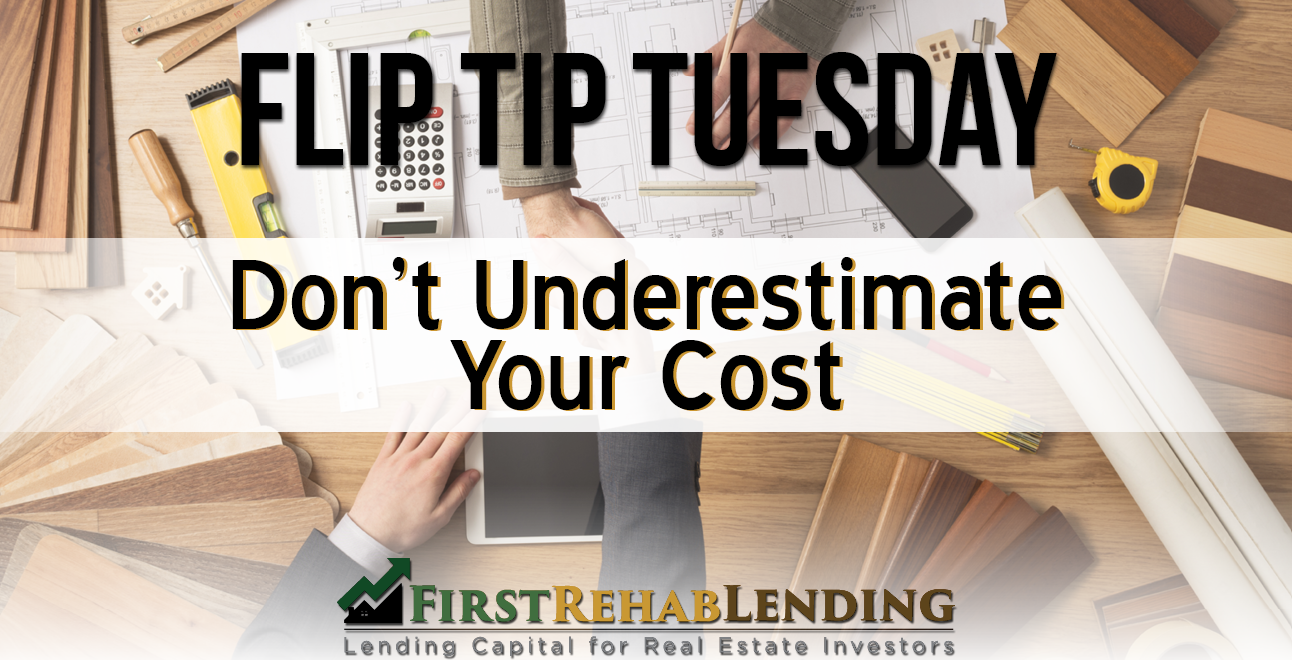
#14: Don’t Underestimate Your Cost
In the world of flipping properties, an investor should live and die by their numbers. After all, it’s those calculations that will determine if the property is worth purchasing, fixing and flipping.
As we examined in Flip Tip 2- Know Your Numbers, the typical costs associated with a flip are the following.
- Acquisition costs (purchase price, inspections, closing costs, recording fees)
- Carrying costs (Insurance, taxes, maintenance, utilities, etc. …)
- Loan costs (appraisal fee, processing fees, interest, points on your loan, etc. …)
- Rehabilitation costs (costs of doing any repairs and renovations)
- Selling costs (real estate commissions, recording fees, closing fees, etc. …)
When figuring out their costs, most people factor in the price of the property, the cost of the rehab and the selling cost. Today we focus on some of the frequently overlooked or underestimated costs.
Acquisition Costs
These are the costs incurred when buying the flip property. Obviously, the biggest cost here is the purchase price of the house. But it does not end there. There are recording fees, which will vary from state to state. These are usually published on the state’s department of finance website. Additionally, there are legal and title fees which can range anywhere from $500 – $2,500. Don’t forget to factor in the cost of the property inspection. If you are financing the purchase of your investment property, there are several costs associated with your loan. Consider application fees, points, interest, appraisal fees and closing costs.
Carrying Costs
These are the costs associated with holding your rehab during the renovation and sale of your investment property. These costs could include: property taxes, utilities, insurance, and association fees. The longer you carry the property in your name, the more expenses you’ll have to put towards these carrying costs. For carrying costs or any other costs, prepare for the worst and hope for the best.
Selling Cost
When it comes time to put your rehab on the market, you need to include the realtor’s fees. As the seller, you will pay the realtor’s commission out of the proceeds from the sale of the property. Realtor’s commission is usually 5% to 6% of the sale price. You can sell your flips on your own, but using an experienced realtor will help you sell the property much faster and often at a higher price point. This helps save money on your soft costs like financing and carrying costs. While the real estate agent markets, shows and sells your flip, you can use this time to pursue your next flip. Don’t forget to factor in at least 1% towards the title and attorney fees.
Before jumping into a rehab, calculating and researching all of the costs and factoring in extra room for unforeseen circumstances is paramount. This will keep your flips profitable and ensure your hard work does not go unrewarded.
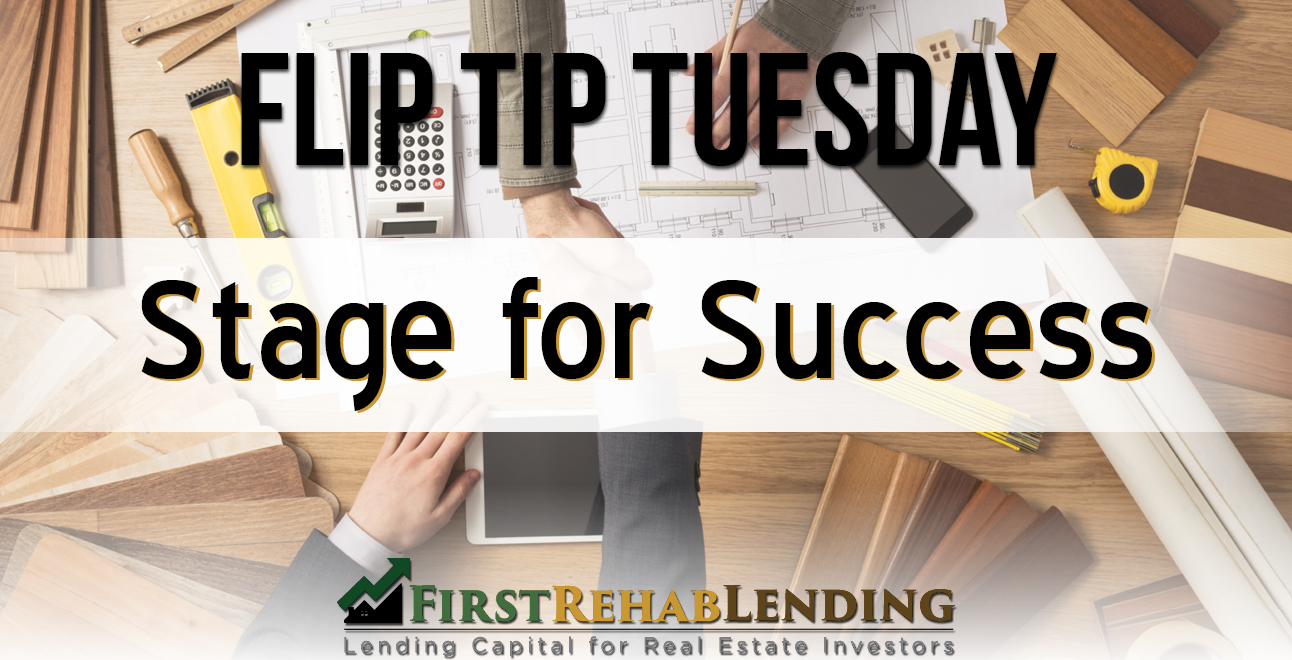
#15: Stage for Success
One of the critical, but often overlooked, parts of the fix and flip process is house staging. Staging allows potential buyers to envision themselves living in the house, which can be tricky to do if the house is empty.
House staging involves furnishing, organizing, and decorating your rehab to show it at an Open House. The reason to stage is to add life to a house and to make it appear homey. Potential buyers attending an Open House have an idea of the type of house they are looking for, and the money they’re looking to spend. Staging a house can sway their final decision by hitting their emotions.
Many in real estate believe an empty house is a blank canvas for buyers and allows them to imagine their belonging there. However, buyers often associate a vacant house with desperate sellers. By staging your rehab you can give the buyers ideas of how they can effectively use the space of the property. To get the best price on your rehab, you must give the impression that the house is livable and can be turned into a “home”.
Appearance is everything when it comes to staging a house. Your focus should be to create an environment that appeals to a variety of buyers in your market, and helps maximize the property’s strengths. The ideal staging method is to present a neutral and minimalist setting. Use neutral colors on walls, but be careful of an all-white approach. It blurs the rooms together in the buyers’ minds. Pay attention to how you arrange the furniture. This can make a space look congested or spacious. If your rehab has smaller rooms, consider pushing the furniture against the wall to create the illusion of a larger space. If you’re dealing with larger rooms, consider setting up the furniture in the middle of the room to create the impression of a room that is spacious yet cozy. The main focus is to help the potential buyers figure out what they can do with a room instead of just presenting them with an empty lifeless space. Also, when showing the house, make sure the house is well lit and nicely decorated. Small inexpensive touches like a welcome mat, guest towels in the bathrooms, candles, flowers, etc… can really make a difference.
Consider hiring a professional stager, especially if the price point of the house is high. Professional stagers are experts at creating a homey environment while keeping the house looking neutral. They are great at highlighting the best features of a house while minimizing any draw-backs. They can also supply temporary belongings such as furniture, plants, artwork, curtains, etc.
Like everything else about a fix and flip, staging the property is an investment in future returns. According to the Real Estate Staging Association, staged properties spend less time on the market and sell for more money. And those results definitely speak for themselves.

#16: Show Off Your Rehab
After you renovate your flip house, it is important to educate the buyer by showing off the work you put in. Create a list of what you did and what you replaced in your flip and let the buyers, agents, inspectors and appraisers see it. Showing them a list of the changes you’ve made in the house gives the buyers peace of mind and elevates the value of your flip house from their perspective.
Most rehab houses tend to be older properties, which can cause concern in a potential buyer’s mind. Disclose every system you added or replaced on the investment; including the appliances, HVAC, electrical, and any structural problems you fixed. List new appliances and fixtures, and have ready on hand all instruction booklets and warranties for the buyer. Let buyers know every detail of how this rehab house is up to today’s standards. By creating a list you are documenting value in your rehab.
Before and after photos or videos of your rehab are a great way to showcase the improvements you’ve made. Show them you did the work, the work was done properly, and they won’t have to replace or fix these areas in the near future. This is a great way to market your company as well. Showing potential buyers and future lenders your history in flips shows value in your skills.
Every potential buyer who walks into your flip must know of the efforts you put into the house to make it better. This not only establishes the value and the asking price, but also serves to sell your flipping skills, and could lead to further opportunities.

#17: Make Sure the Price is Right
It’s easy to fall in love with your rehab after you see the end results of your renovation, and to overestimate the added value to the property, knowing what it looked like before. If you want a successful listing that produces multiple offers, you must price your property correctly. Over- pricing can hurt your profits dramatically by not only yielding less than your asking price, but also by increasing your holding costs because the property will most likely sit on the market longer. Under-pricing, can leave precious profit on the table.
Pricing your flipped home strategically is not about how much you would like to get, but about finding the best price that the right buyer is willing to pay in the market you are in. You bought and renovated the house and deserve a profit. But listing the property at a sale price that you know is too high for that market is more likely to stall the completion of the flipping process than anything else. Inflating the asking price can also negatively affect the market in that area. If buyers are scared off by your over-priced house, they are less likely to keep looking in that area. Over time, this could create a trend in that entire market for home buyers to stay away.
The best source of information for the correct listing price of a house is a good realtor. A realtor can assist you in finding reliable listings and sales of comparable properties in the neighborhood, so that you know what your property is worth. He/she is an expert in the market and will know what price the market can bear.
Keep in mind your buyers didn’t see the house when you started, and the transformation you’ve made. They see the finished product only. They are shopping the market and touring the comparable homes. Every neighborhood has a general price point you need to stay within.
Listing your rehab at the average or slightly below market value in that particular neighborhood can make your property very attractive and increase the traffic of buyers viewing your house. The amplified traffic increases your likelihood of securing competing offers in a shorter time period. So make sure the sale price is fair, but still reflects the new value and profit level you have worked hard to reach.

#18: ‘Tis the season to Flip!
When people think of house hunting or moving, the spring and summer months usually come to mind. However, the winter months can be the perfect time for a real estate investor.
During the winter months the housing market slows down, but this is great news for investors. There are fewer buyers with whom to compete and lower inventory. Many sellers take their houses off the market during the winter months and will try to sell them again during the spring. This usually translates into a market in which houses are priced lower and sellers are very motivated.
After the holidays have passed and the New Year begins, most are getting back into the swing of everyday life and not thinking about buying. Now is the chance for investors to be looking before typical home buyers get back into the mix. There will be fewer buyers in competition during the winter months and the low demand will work in your favor to negotiate better pricing. So for the investor looking for a good deal in the housing market, the winter can be prime time. The markets do vary locally though, so it’s best to gather information on your target market to determine whether this could impact your real estate investment purchase.
While it may be counter intuitive to search for your investment property in the winter; with a little luck, light competition, and some good negotiation skills, it could be the best season to buy. Then you can perform all your renovations during the winter to be ready to list your house at the height of the market, the spring. That makes for great flipping!
